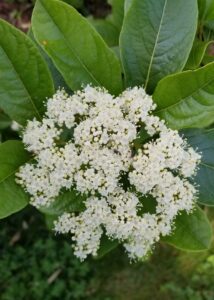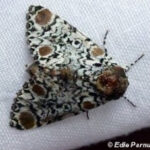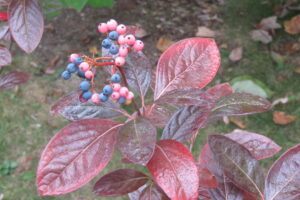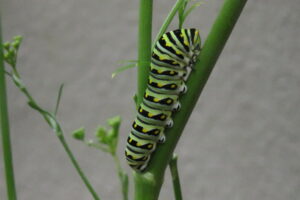By Edie Parnum
Viburnum nudum (Smooth Witherod or Possumhaw) and Zizia aurea (Golden Alexander)
Every year we feature two superior native plant species. One of the Prime Plants for Nature is a tree, shrub, or vine and the other is a perennial. Prime Plants are selected based on these criteria:
- Are native to southeastern Pennsylvania.
- Offer high wildlife value and contribute significantly to your property’s web of life.
- Provide food for wildlife by producing nutritious fruits, seeds, nuts, nectar, or pollen.
- Host insects that are eaten by birds or other animals.
- Offer shelter and places to raise young.
- Are easy to grow and make attractive additions to your landscape.
- Sold at local native plant nurseries and native plant sales.
Here are the 2022 Prime Plants for Nature
Viburnum nudum (previously V. cassinoides), Smooth Witherod or Possumhaw

V. nudum flowers offer pollen for native bees and other pollinators. Photo © Edie Parnum. Cllick to enlarge.
Wildlife Value: This shrub produces berries in fall that are eaten by robins, cardinals, bluebirds, flickers, thrashers, mockingbirds, catbirds, and thrushes. The autumn fruits are high in lipids, a source of energy for the southbound migrants. Native pollinators such as hoverflies, sweat bees, and scarab beetles seek the pollen produced by the spring flowers.

Harris’s three-spot moth’s caterpillar feeds on viburnum foliage. Photo © Edie Parnum. Click to enlarge.
The leaves host 104 species of butterfly and moth caterpillars including the spring azure butterfly and hummingbird clearwing moth. Other valuable native viburnum shrubs include V. acerfolium, V. lentago, V. dentatum, V. prunifolium, and V. trilobum.
Growing Conditions: The witherod viburnum is adaptable to a variety of growing conditions but prefers acidic, moist, well-drained soils in sun or part shade. For best fruit set plant two or more. This shrub has good disease and pest resistance and is not favored by deer. Can be grown singly, in a shrub border, mixed-species hedgerow, or periphery of a rain garden.

Fall fruits provide food for birds, particularly migrants. Photo © Edie Parnum. Click to enlarge.
Appearance: In fall the attractive clusters of pink, purple, blue, and purplish black fruitshang on red stems. The glossy green leaves turn red or reddish purple in autumn. In spring the white flowers are arranged in a flat-topped cluster. This deciduous, multi-stemmed shrub can grow to 8-12 feet with a spread of 5-7 feet. The cultivars ‘Winterthur’ and ‘Brandywine’ are more compact.
Zizia aurea, Golden Alexander
Wildlife Value: Golden alexander blooms in mid to late spring. This long-blooming perennial is an important source of nectar for early bees, flies, wasps, beetles, and small butterflies when few other flowers are available. Mining bee, a native bee, is a specialist that eats this plant’s pollen. A member of the parsley family, golden alexander is a host plant for the black swallowtail butterfly caterpillar. The abundant insects attract predators like spiders and assassin bugs, too.

Black swallowtail butterflies use golden alexander as a host plant. Photo © Edie Parnum. Click to enlarge.
Growing Conditions: These perennials will thrive in part sun or part shade. They prefer moist soil but will do well in average conditions once established, even in clay. Although individual plants live for just a few years, they self-seed to form a long-lasting colony. Not usually browsed by deer. Disease-free.
Appearance: Each flower looks like a single flat-topped umbel but is a cluster of 10-20 small umbellets. The 3” bright yellow spring flowers stand 16-20” high above attractive dark green foliage and are attractive in flower arrangements

